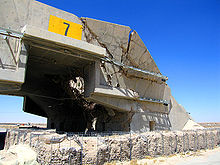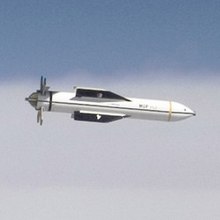Bunker buster
This article includes a list of general references, but it lacks sufficient corresponding inline citations. (August 2013) |
This article's use of external links may not follow Wikipedia's policies or guidelines. (January 2023) |

A bunker buster is a type of munition that is designed to penetrate hardened targets or targets buried deep underground, such as military bunkers.
Armor piercing shells
[edit]Germany
[edit]Röchling shells were bunker-busting artillery shells, developed by the German engineer August Coenders, based on the theory of increasing sectional density to improve penetration. They were tested in 1942 and 1943 against the Belgian Fort d'Aubin-Neufchâteau.[1]
Aircraft delivered bombs
[edit]World War II
[edit]Germany
[edit]In World War II the Luftwaffe developed a series of unguided rocket-propelled armor-piercing bombs for use against shipping and fortifications.
United Kingdom
[edit]

In World War II, the British designer Barnes Wallis, already famous for inventing the bouncing bomb, designed two bombs that would become the conceptual predecessors of modern bunker busters: the five tonne Tallboy and the ten tonne Grand Slam. These were "Earthquake" bombs—a concept he had first proposed in 1939.[3] The designs were very aerodynamic, allowing them to exceed the speed of sound as they fell from 22,000 ft (6,700 m). The tails were designed with offset fins causing the bombs to spin as they fell. Using the same principle as a spinning top, this enabled them to resist being deflected, thereby improving accuracy. They had casings of high grade steel, much stronger than the typical World War II bomb so that they would survive hitting a hardened surface, or penetrate deep into the ground.
Though these bombs might be thought of as "bunker busters" today, in fact the original "earthquake" theory was more complex and subtle than simply penetrating a hardened surface. The earthquake bombs were designed not to strike a target directly, but to impact beside it, penetrate under it, and create a 'camouflet', or large buried cavern, at the same time as delivering a shock wave through the target's foundations. The target then collapses into the hole, no matter how hardened it may be. The bombs had strong casings because they needed to travel through rock rather than reinforced concrete, though they could perform equally well against hardened surfaces. In an attack on the Valentin U-Boat pens at Farge, two Grand Slams went through the 15 ft (4.5 m) reinforced concrete hardening[4]—equalling or exceeding the best current penetration specifications.
The British Disney bomb (officially "4500 lb [2,000 kg] Concrete piercing/Rocket Assisted Bomb", also known as the "Crab") was a World War II device designed to be used against U-boat pens and other super-hardened targets. Devised by Captain Edward Terrell RNVR of the Admiralty's Directorate of Miscellaneous Weapons Development,[5] it had a streamlined hardened case and weighed about 4,500 lb (2,000 kg) including the rocket assembly. The actual explosive content was about 500 lb (230 kg).
For accuracy, the bombs had to be dropped precisely from a pre-determined height (usually 20,000 ft (6,100 m)).[6] They would free-fall for around 30 seconds until, at 5,000 ft (1,500 m), the rockets were ignited, causing the tail section to be expelled.[6] The rocket burn lasted for three seconds[7] and added 300 ft/s (91 m/s) to the bomb's speed, giving a final impact speed of 1,450 ft/s (440 m/s; 990 mph),[7] approximately Mach 1.29.[a] Post-war tests demonstrated that the bombs were able to penetrate a 14-foot-8-inch (4.47 m) thick concrete roof,[8] with the predicted (but untested) ability to penetrate 16 feet 8 inches (5.08 m) of concrete.[8]
United States
[edit]Post war, the US added a form of remote guidance to the Tallboy to create the Tarzon, a 12,000 lb (5,400 kg) bomb deployed in the Korean War against an underground command center near Kanggye.
Modern
[edit]
The BLU-109 bomb is intended to penetrate concrete shelters and other hardened structures before exploding. It entered service in 1985. Israeli F-15I fighter jets are believed to have used BLU-109s in the strikes that killed Hezbollah leader Hassan Nasrallah in Beirut on 27 September 2024.[9][10]
During Operation Desert Storm (1991), there was a need for a deep penetration bomb similar to the British weapons of World War II, but none of the NATO air forces had such a weapon. As a stop-gap, some were developed over a period of 28 days, using old 8 inch (203 mm) artillery barrels as casings. These bombs weighed over two tons but carried only 647 lb (293 kg) of high explosive. They were laser-guided and were designated "Guided Bomb Unit-28 (GBU-28)". It was proven effective for the intended role.[11]
An example of a Russian bunker buster is the KAB-1500L-Pr. It is delivered with the Su-24M and the Su-34 aircraft. It is stated to be able to penetrate 10–20 m of earth or 2 m of reinforced concrete. The bomb weighs 1,500 kg (3,300 lb), with 1,100 kg (2,400 lb) being the high explosive penetrating warhead. It is laser guided and has a reported strike accuracy of 7 m (23 ft) CEP.[12]
The US has a series of custom made bombs such as the Paveway series of laser-guided bombs to penetrate hardened or deeply buried structures:
| Depth of Penetration reinforced concrete |
Weapon Systems | |
|---|---|---|
| 1.8 m (6 ft) | BLU-109 Penetrator | GBU-10, GBU-15, GBU-24, GBU-27, AGM-130, GBU-31(V)3/B & GBU-31(V)4/B |
| 3.4 m (11 ft) | BLU-116 Advanced Unitary Penetrator (AUP) | GBU-15, GBU-24, GBU-27, AGM-130 |
| BLU-118/B Thermobaric Warhead | GBU-15, GBU-24, AGM-130 | |
| more than 6 m (20 ft) | BLU-113 Super Penetrator | GBU-28, GBU-37 |
More recently, the US has developed the 30,000 lb (14,000 kg) GBU-57.
Turkey is another country known to be developing bunker busters, such as the SARB-83 and NEB-84.

Fuzing
[edit]The traditional fuze is the same as a classic armor-piercing bomb: a combination of timer and a sturdy dynamic propeller on the rear of the bomb. The fuze is armed when the bomb is released, and detonates when the propeller stops turning and the timer has expired.
Modern bunker busters may use a traditional fuze, but some also include a microphone and microcontroller. The microphone listens, and the microcontroller counts the number of floors until the bomb breaks through the desired numbers of floors. Northrop Grumman is working on the Hard Target Void Sensing Fuze (HTVSF), an electronic, cockpit programmable, fuze capable of destroying deeply buried and targets. It provides multiple delay arming and detonation times, as well as a void-sensing capability, which allows for precision activation of the fuze for 2,000-and-5,000-pound (910 and 2,270 kg) weapons to explode when they reach an open space in a deeply buried bunker.[13] [14]
Missiles
[edit]
The extra speed provided by a rocket motor enables greater penetration of a missile-mounted bunker buster warhead. To reach maximum penetration (impact depth), the warhead may consist of a high-density projectile only. Such a warhead carries more energy than a warhead with chemical explosives (kinetic energy of a projectile at hypervelocity).
Nuclear
[edit]The nuclear bunker buster is the nuclear weapon version of the bunker buster. The non-nuclear component of the weapon is designed to greatly enhance the penetration into soil, rock, or concrete to deliver a nuclear warhead to a target. These weapons would be used to destroy hardened, underground military bunkers deeply buried. In theory, the amount of radioactive nuclear fallout would be reduced from that of a standard, air-burst nuclear detonation because they would have relatively low explosive yield. However, because such weapons necessarily come into contact with large amounts of earth-based debris, they may, under certain circumstances, still generate significant fallout. Warhead yield and weapon design have changed periodically throughout the history of the design of such weapons. An underground explosion releases a larger fraction of its energy into the ground, compared to an explosion at or above the surface which releases most of its energy into the atmosphere.
See also
[edit]Notes
[edit]- ^ Other sources mention a striking speed of 2,400 ft/s (730 m/s; 1,600 mph). (Johnsen 2003, p. 45, Burakowski & Sala 1960, p. 556)
- ^ "Les étranges obus du fort de Neufchâteau (suite)". derelicta.pagesperso-orange.fr (in French). Retrieved 11 June 2016.
- ^ Project Ruby 1946, p. 214
- ^ "Earthquake Bombs". Barnes Wallis Foundation. Retrieved 2020-11-27.
- ^ RAF staff 2005.
- ^ Terrell 1958, pp. 197–212.
- ^ a b Burakowski & Sala 1960, p. 556
- ^ a b Project Ruby 1946, p. 18
- ^ a b Project Ruby 1946, p. 23
- ^ "Israel likely used U.S.-made 2,000-pound bombs in Nasrallah strike, visuals show". The Washington Post. 29 September 2024.
- ^ "US-made 2,000-pound bombs likely used in strike that killed Hezbollah chief Nasrallah, CNN analysis shows". CNN. 30 September 2024.
- ^ "Why the Pentagon is beefing up its 'bunker buster' bombs".
- ^ Kopp, Carlo (11 August 2009). "Soviet/Russian Guided Bombs". Air Power Australia.
- ^ "ATK Awarded Contract for Hard Target Void Sensing Fuze (HTVSF) Engineering & Manufacturing Development (EMD) Phase". ATK. 5 April 2011.
- ^ "Northrop Grumman Awarded $110 Million for US Air Force Hard Target Void Sensing Fuze". Northrop Grumman Newsroom. February 28, 2020. Archived from the original on March 3, 2020.
References
[edit]- Air Proving Ground Command Eglin Field (31 October 1946). Comparative Test of the Effectiveness of Large Bombs against Reinforced Concrete Structures (Anglo-American Bomb Tests – Project Ruby) (PDF). Orlando, Florida: US Air Force. Archived (PDF) from the original on 8 October 2012. Retrieved 9 June 2011. "Running parallel with the development of large bombs was a project for obtaining high striking velocities by means of a rocket assisted 4,500-lb [2,000 kg] British bomb called the Disney. (...) As early as June 1945, the concrete V-weapon structure at Watten was used as a target".
- Burakowski, Tadeusz; Sala, Aleksander (1960). Rakiety i Pociski Kierowane [Rockets and guided missiles] (in Polish). Vol. Część 1 – Zastosowania (Volume 1 – applications). Warsaw: Wydawnictwo Ministerstwa Obrony Narodowej (Ministry Of National Defense Publishing House). pp. 556–557. Figure 280, p. 558, provides a detailed diagram of the Disney bomb (with its internals).
- Johnsen, Frederick A. (2003). Weapons of the Eighth Air Force. St. Paul, MN: MBI Publishing. p. 45. ISBN 0-7603-1340-7.
- RAF staff (6 April 2005). "Grand Slam Raids". Royal Air Force Bomber Command 60th Anniversary. Archived from the original on 6 July 2007.
- Terrell, Edward (1958). Admiralty Brief: the story of inventions that contributed to victory in the Battle of the Atlantic. Harrap.
Further reading
[edit]- Alekseevskii, V. P. (1966). "Penetration of a rod into a target at high velocity". Combustion, Explosion, and Shock Waves (Fizika Goreniya i Vzryva). 2 (2): 99–106. doi:10.1007/BF00749237. ISSN 0010-5082. S2CID 97258659.
- Bernard, Robert S. (1978). Depth and Motion Prediction for Earth Penetrators (PDF) (Report). Vol. ADA056701. Army Engineer Waterways Experiment Station Vicksburg. Archived from the original on 2012-10-08. Retrieved 2015-12-07.
- Parsch, Andreas (2006). "Textron (Avco) BLU-106/B BKEP (Boosted Kinetic Energy Penetrator)". Directory of U.S. Military Rockets and Missiles fitted with bunker busting bombs to extend distances and to have horizontal as well as vertical movement and control. (Appendix 4). Retrieved 27 June 2011. US rocket-boosted submunition against runways and hardened aircraft shelters.
- Young, C.W. (1997). Penetration equations (PDF) (Report). Vol. SAND94-2726. Albuquerque NM: Sandia National Laboratories.
This is a standalone report documenting the latest version of the Young/Sandia penetration equations and related analytical techniques to predict penetration into natural earth materials and concrete.
- Young, C.W. (1967). The Development Of Empirical Equations For Predicting Depth Of An Earth Penetrating Projectile (Report). Vol. SC-DR-67-60. Albuquerque NM: Sandia National Laboratories.
External links
[edit]- Guided Bomb Unit-28 (GBU-28) BLU-113 Penetrator
- BBC: 'Bunker buster' missiles aim at Moon
- Annotated bibliography for nuclear bunker buster bombs from the Alsos Digital Library for Nuclear Issues
- Read Congressional Research Service (CRS) Reports regarding Bunker Busters
- Video against usage (produced by Union of Concerned Scientists)
- Video of bunker buster bomb in action
- Tunnel buster bomb
